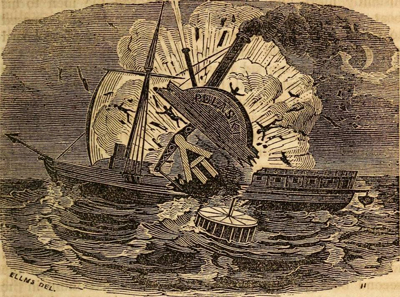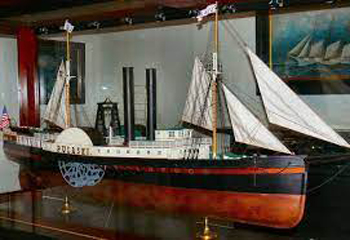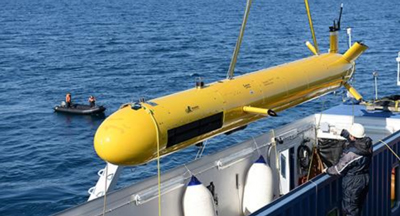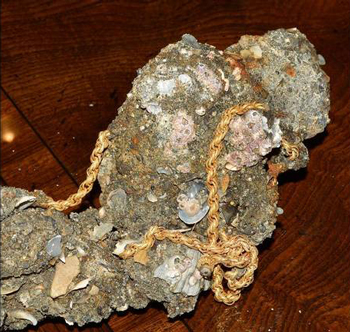The SB Pulaski: A Story of Tragedy, Romance and Treasure

Drawing from early newspaper depicts explosion aboard the SB Pulaski, June 13, 1898. Credit: North Carolina Dept. of Natural and Cultural Resources
The vessel, one of four sailing under the Savannah, Georgia, and Charleston, South Carolina, Steam Packet Company flag, left Savannah on June 13 with 102 passengers and crew plus a load of U.S. Post Office mail packets. After a stop in Charleston, where it boarded 65 more passengers, the paddle wheel steamer headed for Baltimore, Maryland, its final destination. When Capt. John Dubois left Charleston, the boat was making headway in moderate seas until it reached the coast of North Carolina. It was about 10 p.m., after most of the passengers had turned in, that a loud explosion startled and shook everyone aboard. One of the steamer’s two copper boilers, allowed to overheat by neglectful engineers, exploded and instantly killed many passengers and crew including the captain. Those who didn’t die from being scalded to death drowned while the Pulaski sank within 45 minutes of the blast.

Model shows elegant paddle wheeler SB Pulaski. Credit: Ships of the Sea Museum, Savannah, Georgia.

High tech equipment enabled salvors to locate the shipwreck. Credit: Blue Water Ventures International.
Help finally arrived. The schooner Henry Camerdon picked up 30 survivors, while more vessels out of Wilmington saved some of the others. While recuperating aboard ship, Mr. Ridge confessed that his entire fortune, $25,000, went down with the steamboat. He told her she could opt out of their engagement. With tears streaming down her face, she reminded him of what he told her aboard the raft: “We will either live or die together.” She told him money or lack of it wasn’t an issue. She held back at that moment, not wanting to shock him, but told him later that she was heiress to a $200,000 family estate. (It would be worth $3.5 million today). The couple married and settled in Baltimore where he opened a successful business on the waterfront. Their love story and his heroics were reported in newspapers throughout the world.

Gold and silver coins were found in the rubble. Credit: Blue Water Ventures International
Salvage divers searched many years for the paddlewheel steamboat, but it wasn’t until the summer of 2018 that a surprising discovery was made by Blue Water Ventures International, a company out of Jacksonville, Florida. Partnered with Endurance Exploration, Clearwater, Florida, the salvage teams used high tech sonar with cutting edge transducers to pick up a debris field that was missed in the past by other subsea operators. Broken in two when it sank, the boat left a long trail of flotsam and jetsam far offshore, not far from the Gulf Stream. Searching a mile beyond the original recorded wreck site, divers found the boat’s stern and keel in 115 feet of water. Another large pile of wreckage was detected two miles to the south.

Gold chain belonging to one of the passengers was found on encrustation from the shipwreck. Credit: Blue Water Ventures International
As in many disasters at sea, when equipment fails or periodic inspections have been neglected, something good comes from something bad. In this case, public opinion prompted Congress to pass regulations that governed steamer inspections, earmarking the vessels’ engine rooms and lifeboats. The victims of the Pulaski’s demise didn’t die in vain. Other passengers, aboard other ships at other times, could have faced disaster at sea, but were saved by preventive safety measures, particularly a competent workforce in the engine room and sturdy lifeboats.
Note: Special thanks to Jack McDonald, Prof. Emeritus, Towson University, Towson, Md. for helping with the research on the SB Pulaski.
Author: Ellsworth Boyd
Ellsworth Boyd, Professor Emeritus, College of Education, Towson University, Towson, Maryland, pursues an avocation of diving and writing. He has published articles and photo’s in every major dive magazine in the US., Canada, and half a dozen foreign countries. An authority on shipwrecks, Ellsworth has received thousands of letters and e-mails from divers throughout the world who responded to his Wreck Facts column in Sport Diver Magazine. When he’s not writing, or diving, Ellsworth appears as a featured speaker at maritime symposiums in Los Angeles, Houston, Chicago, Ft. Lauderdale, New York and Philadelphia. “Romance & Mystery: Sunken Treasures of the Lost Galleons,” is one of his most popular talks. A pioneer in the sport, Ellsworth was inducted into the International Legends of Diving in 2013.
4 Comments
Submit a Comment
All Rights Reserved © | National Underwater and Marine Agency
All Rights Reserved © | National Underwater and Marine Agency
Web Design by Floyd Dog Design
Web Design by Floyd Dog Design

Going back many years when Ells and I were both young teachers in Maryland I always felt the excitement of being with an ‘explorer’. I longed for his stories when we would return from school vacations and he had been off of perhaps the shores of Aruba, exploring the Ocean floors or photographing the various sites he would come across. After staying in touch the many years, I still yearn for those vivid descriptions and the romance that is woven into the events. This all comes to life again in this most recent publication.
Monica: Thank you, thank you, thank you! I didn’t realize that you used to look forward to my diving adventures. Those were grand old days. We had a wonderful administration, a friendly faculty and very nice children and parents. Very, very fond memories. I’m so glad we continue to stay in touch. Cheers, Ells
Mr. Boyd paints a very vivid picture of the romance and tragedy of the sea. His article piqued my curiosity about the Pulaski and its’ passengers and I will be interested in finding out more on this forgotten story. It is always good to “find a silver lining” in tough times. Wondering what new treasures Blue Water Ventures will find – the story continues.
Many thanks for your comment. Yes, the story continues as Blue Water Adventures and their divers search for more artifacts. I will be reviewing a book, “Surviving Savannah” by Patti Callahan. It is fiction based on fact and the fictional part includes the Pulaski and the love affair that evolved from it. So stay tuned.